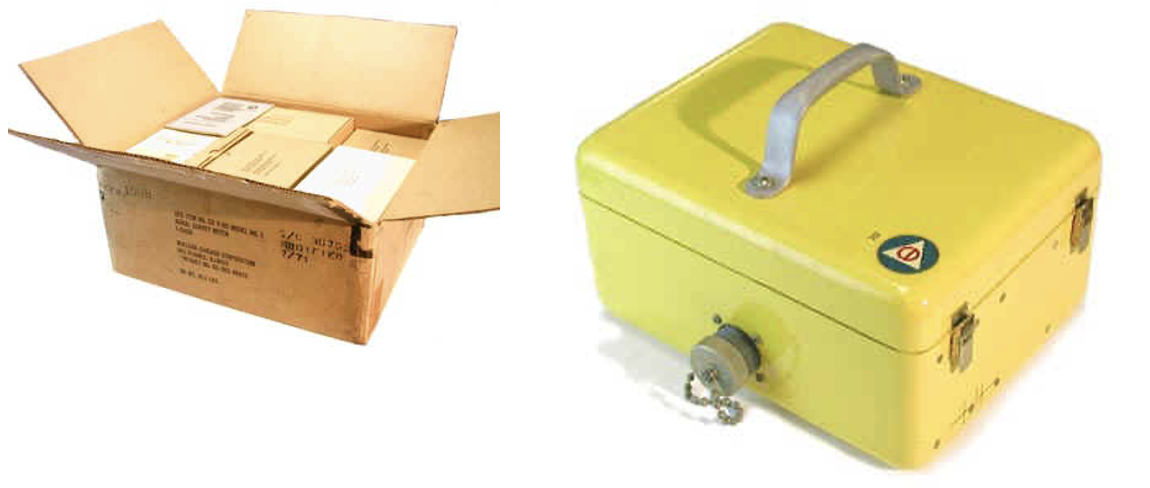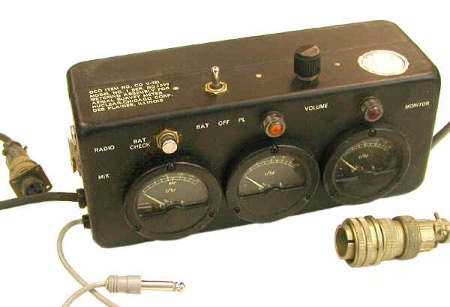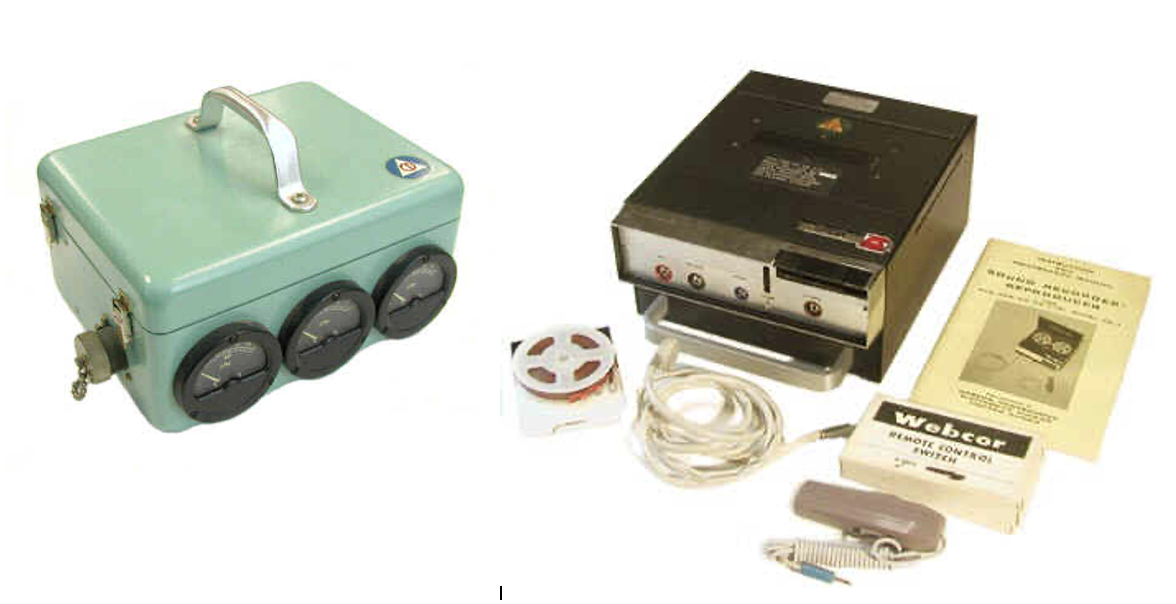CD V-781 Aerial Survey Meter (1963)
The CD V-781 aerial survey system was "designed for use in relatively low-flying air-craft. Use of aerial survey permits coverage of large areas quickly and allows highly contaminated areas to be monitored with minimum exposures to operating personnel." It was "designed for general post-attack surveying by light aircraft after fallout has been deposited." Each state was provided with at least one CD V-781—they were not distributed at the local level. In general, the CD V-781s were to be stored near the airports that the flights would take off from. Non-carrier aircraft were to be used.
The system consists of four major components: the detector unit, the meter unit, the simulator unit, and a tape recorder.
The detector unit (below right) contains three GM detectors and a high voltage supply including nine 1.5 volt "D" cells. In normal use, it would be mounted on the floor of the aircraft as close as possible to the outside skin of the plane. The mounting brackets are not shown.

The metering assembly shown below employs three meters: the one on the left for 0 - 0.1 R/hr, the one in the middle for 0 - 1.0 R/hr, and the one on the right for 0 - 10 R/hr. An amber light over the 0 - 1 R/hr meter and a red light over the 0 - 10 R/hr meter indicate when these particular meters are to be read. Each meter is coupled to its own GM tube in the detector unit. The audio output from the assembly can be monitored via headphones (not shown). There are also connections to the aircraft electrical system, radio and, of course, the detector unit.

The photograph below left shows the simulator training module. The simulator is intended to be used instead of the meter unit during in-flight training missions. The photo below right shows the tape recorder. Its purpose is to record the aircraft crew's comments concerning the radiation levels and the planes coordinates. The tape recorder comes with several blank tapes one of which is seen on the left side of the photo. There is also a microphone (just to the right of the tape) and a remote switch (lower right) for turning the unit on and off.

Perhaps the best description of the CD V-781's purpose is found in the OCD Annual Report for FY 1964: "To supplement radiological monitoring by fixed stations and their mobile surface teams, OCD plans call for establishing aerial monitoring at approximately 5,000 airports and landing strips. Aerial monitoring would be necessary for several reasons: e.g., inoperability of some fixed stations as a result of damage; inoperability of surface mobile monitoring because of excessive radiation; and need for early, rapid monitoring to plan immediate post-attack emergency operations and for a practical means of rapidly monitoring farming and grazing lands, as well as other large rural areas" and "According to arrangements coordinated with the U.S. Air Force and the Federal Aviation Agency (FAA), the Civil Air Patrol (CAP) is expected to perform a major portion of aerial monitoring, and all States have made arrangements with the CAP for this service."
The earliest reference that I have found to a Civil Defense aerial monitoring system is in an OCDM Civil Defense Technical Bulletin revised in June of 1959. It refers to an "extremely sensitive gamma radiation aerial survey instrument for rapidly surveying areas from aircraft (CD V-780). (Experimental; not a stock item)." The device was intended to use a sodium iodide scintillator. The Bulletin stated that "Until this instrument is available, the CD V-710 is recommended for aerial survey work." The 1962 Annual Report of the Office of Civil Defense (OCD), the successor to the OCDM, noted that Oak Ridge National Laboratory (ORNL) began work on the development of the CD V-781 in November of 1959. The Report also commented that "until a special aerial instrument, currently being developed, becomes operationally available, the CD V-710 or CD V-715 survey meters furnished by OCD are satisfactory for this purpose."
The following details regarding the development of this instrument were provided in the FY 1961 Annual Report of the OCDM: "the Oak Ridge National Laboratory is engaged in the design and manufacture of prototype radiological survey meters to be used in the measurement of ground-level dose rates by low flying aircraft. The prototype aerial radiation survey meter will be flight-tested and evaluated under simulated emergency conditions in the Milwaukee metropolitan area." The next year (1962), an article in the January issue of Nucleonics noted that ORNL was developing the CD V-781X, an experimental device "for determining ground-level gamma dose rates from low-flying aircraft" that "consists of three G-M detectors sensitive in the 0-0.1-, 0-1- and 0-10r/hr range." According to the Office of Civil Defense (OCD) FY 1962 Annual Report, the flight test in Milwaukee was conducted in January of that year.
The OCD Annual Report for FY 1963 indicated that 1,250 of these were ordered that year.
To the best of my knowledge, the only version of the CD V-781 is the Model 1 that was manufactured in 1963 by Nuclear Chicago. All 1250 of these units were said to remain in the national inventory in 1986 (CPG 3-1).
Retrofitting of the CD V-781s began in 1971. Quoting the OCD Annual Report for that year: "A retrofit program was also initiated at one Federal radef depot to modify the CD V-781 Aerial Survey Meter. The modification increases the reliability of the system under extended use."
Approximate Cumulative Procurement, Inventory and Distribution of CD V-781s*
| Fiscal Year | Procured | Inventoried | Distributed |
|---|---|---|---|
| FY 1962 | - | - | - |
| FY 1963 | 1,250 ordered, none delivered | ||
| FY 1964 | 1,250 ordered, none delivered | ||
| FY 1965 | 1.065 | - | 9 |
| FY 1966 | 1,250 | 1,121 | 129 |
| FY 1967 | 1,250 | 1,056 | 194 |
| FY 1968 | 1,250 | 979 | 218 |
| FY 1969 | 1,250 | 905 | 345 |
| FY 1970 | 1,250 | 882 | 368 |
| FY 1971 | 1,250 | 760 | 490 |
| FY 1972 | 1,250 | 716 | 534 |
| FY 1973 | 1,250 | 585 | 665 |
| FY 1974 | 1,250 | 409 | 841 |
*The numbers in the above table should be considered approximate. I compiled them from data in the Annual Statistical Reports of the OCDM, OCD and DCPA. By "procured," I mean delivered by the manufacturer to the OCDM, OCD or DCPA. "Inventoried" means stored in a Federal (rather than state) warehouse ready for distribution. "Distributed" means sent to the end user. The latter primarily means the states, but also various federal agencies and even foreign governments. The number of procured instruments may be greater than the combined number of inventoried and distributed instruments for a variety of reasons: some may have been sent back to the manufacturer, some may have been disposed of, the numbers might be incorrect, etc.

The above photo, from the FY 1966 Annual Report of the OCD, is titled "Aerial radiological monitoring equipment." Note the two CD V-138, two CD V-730, and two CD V-740 dosimeters. Why no CD V-742s?
Donated by the State of Iowa courtesy of Frank Klier and the State of Wisconsin courtesy of Michael Mack.
References
- Office of Civil Defense. Handbook for Aerial Radiological Monitors.FG-E-5.9.1, July 1966.
- Office of Civil Defense. Operator's Instruction Manual 1970. Aerial Survey Meter.
- Office of Civil Defense. Radiological Monitoring Instruments and Equipment. 1963.
- Federal Emergency Management Agency. Aerial Radiological Monitoring Course Student Manual. SM 84 Sept. 1987.
- Federal Emergency Management Agency. Radiological Instruments: An Essential Resource for National Preparedness. CPG 3-1, September 1986.
